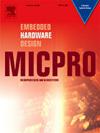Hardware implementation of a high-resolution auto-tuned time-frequency signal analyzer over TMS320C6713 DSK using a compact support polynomial kernel
IF 2.6
4区 计算机科学
Q3 COMPUTER SCIENCE, HARDWARE & ARCHITECTURE
引用次数: 0
Abstract
This paper explores the hardware implementation of an embedded time-frequency signal analyzer using the Polynomial Cheriet-Belouchrani Distribution (PCBD) with a compact kernel. We implemented this distribution on a Texas Instruments TMS320C6713 Digital Signal Processing Starter Kit (DSK). Compared to other quadratic time-frequency distributions (TFDs), the PCBD requires a low computational cost due to its compact support nature, which reduces the number of points needing calculation. The sole smoothing parameter γ that controls its kernel's bandwidth is an integer, simplifying the unsupervised approach. To ensure that the realized TF analyzer is automatically tuned, an accurate low-complexity performance measure must be employed to achieve optimal concentration, resolution, and cross-term suppression. Failure to do so may result in missing or degraded essential signal characteristics. The Stankovic measure has been identified as the preferred measure among many others for finding the optimal value of the integer γ. We have also been exploring methods to optimize the execution of various algorithms by taking advantage of specific mathematical properties inherent in the compact polynomial kernel and the PCBD. Additionally, we propose a recursive method to minimize the computation cost associated with the discrete PCB kernel. These strategies are designed to enhance efficiency and reduce the required machine cycles. To compare the performances provided, we thoroughly evaluate the numerical complexity of our implemented distribution, both with and without mathematical optimization. The findings obtained demonstrate the effectiveness of using the TMS320C6713 DSK board to design a high-resolution auto-tuned time-frequency signal analyzer. We not only achieved a perfect match with the results obtained from MATLAB, but the optimized approach also reduced runtime by approximately 19 % to 47 % compared to the direct method, depending on the input signal length and the number of loops required to optimize the Stankovic measure. A comparative analysis was also conducted to assess the effectiveness of our approach in relation to other linear and quadratic TF analyzers, including those implemented on field-programmable gate arrays (FPGAs).
基于TMS320C6713 DSK的高分辨率自调谐时频信号分析仪的硬件实现,采用紧凑的支持多项式核
本文探讨了一种嵌入式时频信号分析仪的硬件实现,该分析仪采用具有紧凑核的多项式cherieet - belouchrani分布(PCBD)。我们在德州仪器TMS320C6713数字信号处理入门套件(DSK)上实现了这个分布。与其他二次时频分布(TFDs)相比,PCBD的计算成本较低,因为它具有紧凑的支撑特性,减少了需要计算的点的数量。控制其核带宽的唯一平滑参数γ是一个整数,简化了无监督方法。为了确保所实现的TF分析仪自动调谐,必须采用精确的低复杂度性能测量来实现最佳浓度、分辨率和交叉项抑制。如果不这样做,可能会导致丢失或降级的基本信号特性。Stankovic测度已被确定为在许多其他测度中寻找整数γ的最优值的首选测度。我们也一直在探索利用紧多项式核和PCBD中固有的特定数学性质来优化各种算法执行的方法。此外,我们提出了一种递归方法来最小化与离散PCB内核相关的计算成本。这些策略旨在提高效率并减少所需的机器周期。为了比较所提供的性能,我们彻底地评估了我们实现的分布的数值复杂性,无论是否进行了数学优化。实验结果证明了利用TMS320C6713 DSK板设计高分辨率自调谐时频信号分析仪的有效性。我们不仅实现了与MATLAB得到的结果的完美匹配,而且优化后的方法与直接方法相比,运行时间减少了约19%至47%,具体取决于优化Stankovic测量所需的输入信号长度和循环数量。还进行了比较分析,以评估我们的方法与其他线性和二次型TF分析仪(包括在现场可编程门阵列(fpga)上实现的分析仪)的有效性。
本文章由计算机程序翻译,如有差异,请以英文原文为准。
求助全文
约1分钟内获得全文
求助全文
来源期刊

Microprocessors and Microsystems
工程技术-工程:电子与电气
CiteScore
6.90
自引率
3.80%
发文量
204
审稿时长
172 days
期刊介绍:
Microprocessors and Microsystems: Embedded Hardware Design (MICPRO) is a journal covering all design and architectural aspects related to embedded systems hardware. This includes different embedded system hardware platforms ranging from custom hardware via reconfigurable systems and application specific processors to general purpose embedded processors. Special emphasis is put on novel complex embedded architectures, such as systems on chip (SoC), systems on a programmable/reconfigurable chip (SoPC) and multi-processor systems on a chip (MPSoC), as well as, their memory and communication methods and structures, such as network-on-chip (NoC).
Design automation of such systems including methodologies, techniques, flows and tools for their design, as well as, novel designs of hardware components fall within the scope of this journal. Novel cyber-physical applications that use embedded systems are also central in this journal. While software is not in the main focus of this journal, methods of hardware/software co-design, as well as, application restructuring and mapping to embedded hardware platforms, that consider interplay between software and hardware components with emphasis on hardware, are also in the journal scope.
 求助内容:
求助内容: 应助结果提醒方式:
应助结果提醒方式:


